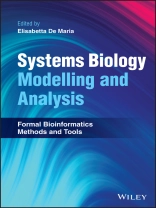Systems Biology Modelling and Analysis
Describes important modelling and computational methods for systems biology research to enable practitioners to select and use the most suitable technique
Systems Biology Modelling and Analysis provides an overview of state-of-the-art techniques and introduces related tools and practices to formalize models and automate reasoning for systems biology. The authors present and compare the main formal methods used in systems biology for modelling biological networks, including discussion of their advantages, drawbacks, and main applications.
Each chapter includes an intuitive presentation of the specific formalism, a brief history of the formalism and of its applications in systems biology, a formal description of the formalism and its variants, at least one realistic case study, some applications of formal techniques to validate and make deep analysis of models encoded with the formalism, and a discussion on the kind of biological systems for which the formalism is suited, along with concrete ideas on its possible evolution.
Edited by a highly qualified expert with significant experience in the field, some of the methods and techniques covered in Systems Biology Modelling and Analysis include:
* Petri nets, an important tool for studying different aspects of biological systems, ranging from simple signaling pathways to metabolic networks and beyond
* Pathway Logic, a formal, rule-based system and interactive viewer for developing executable models of cellular processes
* Boolean networks, a mathematical model which has been widely used for decades in the context of biological regulation networks
* Answer Set Programming (ASP), which has proven to be a strong logic programming paradigm to deal with the inherent complexity of biological models
For systems biologists, biochemists, bioinformaticians, molecular biologists, pharmacologists, and computer scientists, Systems Biology Modelling and Analysis is a comprehensive all-in-one resource to understand and harness the field’s current models and techniques while also preparing for their potential developments in coming years with the help of the author’s expert insight.
Spis treści
Chapter 1 Introduction
Chapter 2 Petri Nets for Systems Biology Modelling and Analysis
Chapter 3 Process Algebras in Systems Biology
Chapter 4 The Rule-based Model Approach. A Kappa Model for Hepatic Stellate Cells Activation by TGFB1
Chapter 5 Pathway Logic: Curation and Analysis of Experiment-based Signaling Response Networks
Chapter 6 Boolean Networks and their Dynamics: the Impact of Updates
Chapter 7 Analyzing Long-Term Dynamics of Biological Networks with Answer Set Programming
Chapter 8 Hybrid Automata in Systems Biology
Chapter 9 Ordinary Diffential Equations
Chapter 10 Network Modeling Methods for Precision Medicine
Chapter 11 Conclusion
O autorze
Elisabetta De Maria, Ph D, is an Associate Professor at the Université Côte d’Azur. From 2011-13, she was Coordinator of the International Research Master Program 'Computational Biology and Biomedicine’ at the University of Nice-Sophia Antipolis. Dr. De Maria has expertise in bioinformatics and computational systems biology and served as program chair of the conferences BIOINFORMATICS 2019, CSBio 2019 (International Conference on Computational Systems-Biology and Bioinformatics), and BIOINFORMATICS 2020.












